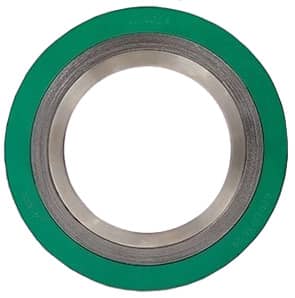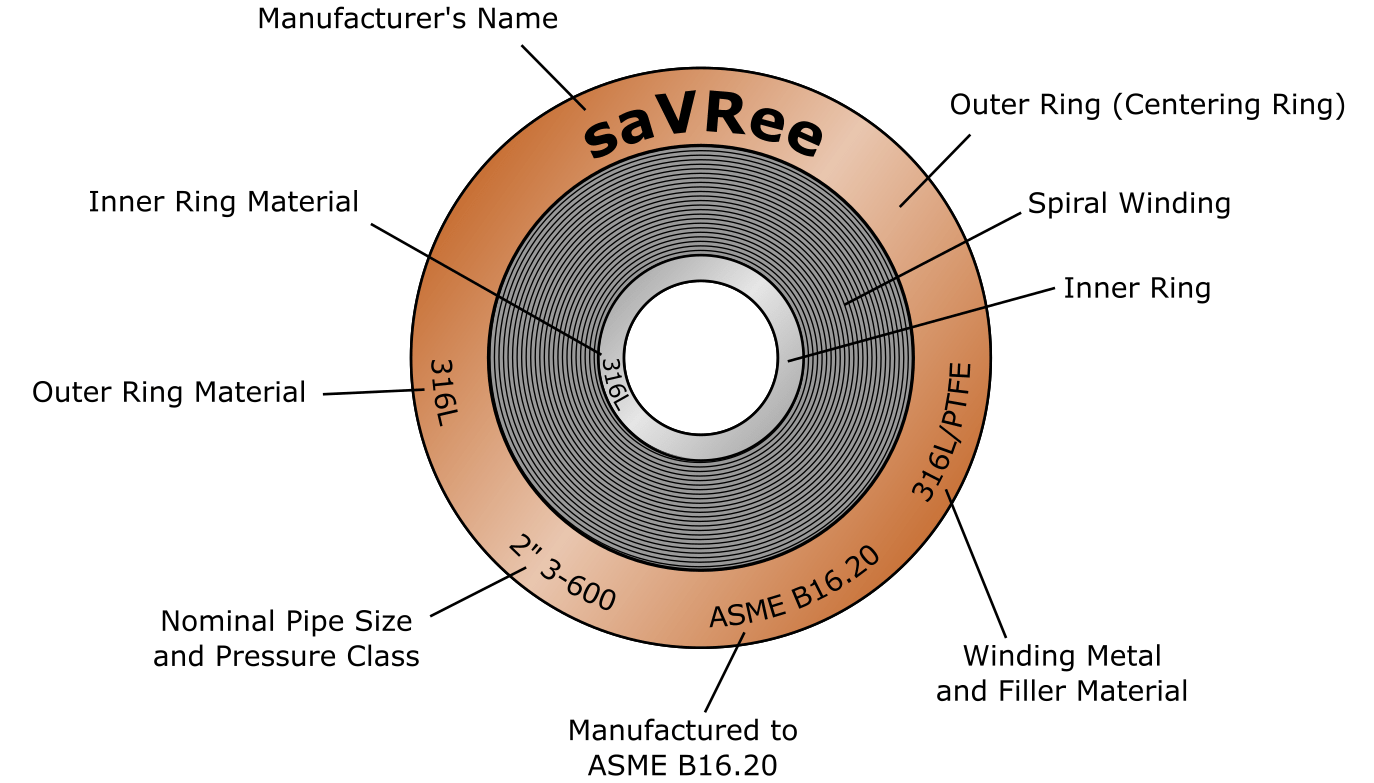What are flange gaskets?
Gaskets are sealing elements installed between mating flange faces. The compressive force applied when flanges are mated (due to bolt torqueing) keeps the gasket in position between the two flanges. Flange gaskets are split into three main categories.
- Non-metallic / Soft – Compressed non-asbestos fibre (CNAF), PTFE, rubber, ceramic fibre.
- Metallic / Hard – oval ring, octagonal ring.
- Semi-metallic / Composite – spiral wound, metal jacketed, camprofile.

Are you enjoying this article so far? Then be sure to check out our Flange Fundamentals Video Course. The course has over five hours of video content, a 52 page colour illustrated handbook (this article is an extract from the handbook), a quiz, and you will receive a certificate of completion when you finish the course. Enjoy!
Soft Gaskets
Soft gaskets (non-metallic gaskets) have a large contact sealing area and are suitable for low pressure applications only. The usage of soft gaskets is mostly restricted to flat face flanges, although it is possible to use them with raised face flanges also. Irrespective of the type of flange used, a soft gasket should be installed on a serrated flange surface to avoid poor sealing.
.jpg)
Compressed Non-Asbestos Fibre Gasket (soft gasket)
The general appearance of most soft gaskets is that they are thin and malleable (can be bent by hand); they are often delivered in rolls and have to be unwound before use. Typical construction materials for soft gaskets are:
- Elastomers (natural and synthetic rubber), compressed non-asbestos fibre (CNAF), PTFE, rubber, ceramic fibre, flexible graphite.
Soft gaskets are ill suited for medium to high pressure applications and are rarely used for system pressures exceeding 20 bar (290 psi). As this type of gasket is mostly used in conjunction with flat face flanges, its pressure class usage is limited to a maximum of 250.
Soft gaskets are cut to include or exclude the bolt holes. If the bolt holes are excluded, the gasket is termed a ‘flat ring’ gasket and should be used with a raised face flange. If the bolt holes are included, the gasket is termed a ‘full face’ gasket and should be used with a flat face flange.
Tip – its possible to use a soft flat ring gasket with a full-face flange, but this should be avoided. The contact sealing face of a full-face flange is designed to extend from the interior diameter of the flange, to its exterior diameter. If a flat ring flange is used, the actual sealing area is far less than in the original design, thus the possibility for leakage increases considerably.
Hard Gaskets
Hard gaskets (metallic gaskets) have a small contact sealing area and are used for medium to high pressure applications. Because metallic gaskets are ‘hard’, they must have a small sealing face in order to achieve the pressure required to deform the gasket and obtain a reliable seal. The most common type of metallic gasket is the ring-type joint, although others exist e.g. lens ring.
Typical construction materials for hard gaskets are:
- Various grades of steel (using chromium and/or molybdenum as alloy material), copper, soft iron.
%20Gasket.jpg)
Ring-Type Joint (RTJ) Gasket
Composite Gaskets
Composite gaskets consist of two or more materials. The soft material is placed between the sealing faces of a flange to create the required seal. The hard material gives the gasket greater rigidity and sturdiness, which helps the softer material resist deformation effects such as squeezing, buckling, and blow-out. Composite gaskets are used across a wide range of pressures and temperatures and are thus available in all pressure classes.

Spiral Wound Composite Gasket
Composite gaskets can be split into three main categories, these are the spiral wound, metal jacketed and camprofile. Of these three, the spiral wound type is by far the most common. A composite gasket may be used with a raised face flange, tongue-and-groove flange, or a male-and-female flange.

Spiral Wound Composite Gasket Labels
Screw Thread Sealing Agents
The application of threaded joints is limited to low pressure, small bore piping. As threads are often machined with imperfections, some form of sealing agent is usually used. Common sealing agents include:
- Liquid sealant – a form of liquid lubricant often combined with compounds such as zinc, copper, or nickel. Linseed oil is a common liquid lubricant, but only suitable for use with high quality threads.
- Plumbers hemp and paste – used for sealing poorly manufactured threads. This type of sealant is also referred to as ‘horse hair and paste’. Hemp has mostly replaced the use of horse hair in today’s markets.
- Thread seal tape – also known as ‘plumber’s tape’ and ‘PTFE tape’. Tape is wrapped onto the threads and forms a similar function to a gasket, (the tape is squeezed between the male and female threads to form a seal). Technically, PTFE tape is a lubricant and not an adhesive, although many people are unaware of this.
- Pipe dope – a combination of a sealing material and solvent carrier. Pipe dope is applied using a brush or spatula to the male thread, then the joint is assembled. The solvent carrier then evaporates leaving the sealing material sandwiched between the male and female thread surfaces.
- Anaerobic resin compounds – a type of sealant that cures when air is no longer present; superglue is a type of anaerobic adhesive.
There are advantages and disadvantages associated with each type of sealing agent. Some are not suitable for high temperature (PTFE tape) and high pressures (all tape types). Others shrink or crack during the curing process (pipe dope). Others are dirty to work with (plumbers hemp), or comparatively expensive (anaerobic resin compounds). For low pressures and temperatures, such as domestic plumbing applications, plumber’s hemp and thread tape are the most popular sealing agents.
Tip - when applying sealing tape to a screw thread, it is essential that the tape is applied in the same direction as that which the female thread will be wound onto the male thread. If the winding direction of the tape is incorrect, the female thread will unwrap the tape as it is wound onto the male thread (thus no seal is obtained).
Flange Types, Faces, and Surfaces - Explained!
This video is part of our Piping Flange Fundamentals Video Course
Related Online Engineering Courses
Introduction to Valves (short course)
Introduction to Centrifugal Pumps
How Multistage Centrifugal Pumps Work
How Hand Pumps Work (hydraulic water pump)
Plate Heat Exchanger Fundamentals
Introduction to Heat Exchangers
How Plate Heat Exchangers Work
Sub-Critical, Supercritical, and Ultra-Supercritical Boilers
Heat Recovery Steam Generators Explained
Additional Resources
http://www.wermac.org/flanges/flanges_raised-face_flat-face_ring-type-joint.html
https://www.kamleshmetal.com/flanges-faces-types.html
https://www.theprocesspiping.com/introduction-to-flanges
